The weapons used to strike Syria
A look at the weapons and platforms used to conduct strikes against Syria after an alleged chemical attack
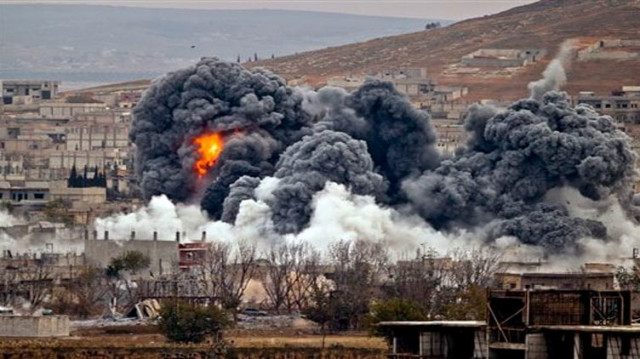
US President Donald Trump announced the military action from the White House, saying the three allies had "marshalled their righteous power against barbarism and brutality".
As he spoke, explosions rocked Damascus. The bombing represents a major escalation in the West's confrontation with Assad's superpower ally Russia, but is unlikely to alter the course of a multi-sided war which has killed at least half a million people during the past seven years.
US, France, Britain launch strikes on Syria
Here is a brief look at some of the weapons the allied forces used to target facilities inside the Syrian capital and across the country, according to CNN.
UK Tornado fighters
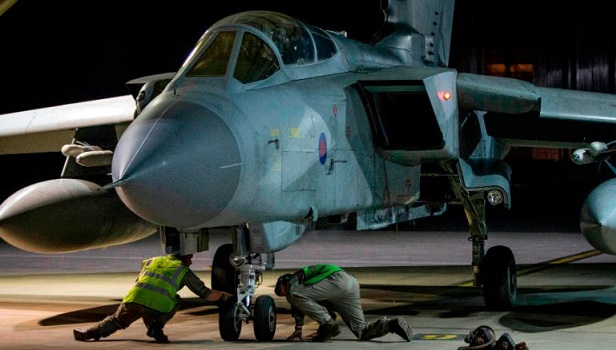 An RAF Tornado taxis into its hangar after landing in Akrotiri after completing its mission. PHOTO COURTESY: CNN
An RAF Tornado taxis into its hangar after landing in Akrotiri after completing its mission. PHOTO COURTESY: CNNThe United Kingdom took part in the bombardment with four Tornado fighter jets which were armed with Storm Shadow cruise missiles, according to the British defence ministry.
Reports suggested that the aircraft took off from the Royal Air Force Base Akrotiri in Cyprus. It targetted a Syrian chemical weapons site in Homs province.
VIDEO captures Syrian missile defense weapons at base targeted in US-led air strikes https://t.co/FV5wwawp73 #Syria pic.twitter.com/58zxLWGbdC
— RT (@RT_com) April 14, 2018
The Tornado GR4 is considered the main ground-attack aircraft of the Royal Air Force (RAF), and the twin-engine jet can be armed with Storm Shadow missiles. The missiles are capable of carrying a 400-kilogram warhead and has a range of 400 kilometres. The aircraft would not have needed to enter Syrian airspace to launch strikes.
French Rafale jets
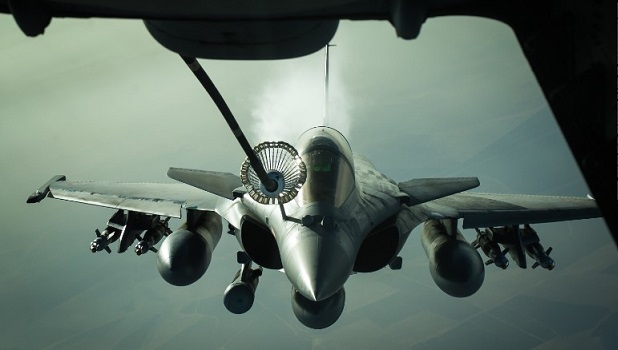 A French Dassault Rafale receives fuel from a KC-10 tanker in 2016. PHOTO COURTESY: CNN
A French Dassault Rafale receives fuel from a KC-10 tanker in 2016. PHOTO COURTESY: CNNFrench Defense Minister Florence Parly told reporters that Rafale jets flew from bases inside France. The office of the French president also tweeted videos of the jets taking off for their mission.
Décollage, cette nuit, des forces armées françaises qui interviennent contre l’arsenal chimique clandestin du régime syrien. Déclaration du Président de la République @EmmanuelMacron : https://t.co/HNSK0FmZIO pic.twitter.com/DEAW7R50aC
— Élysée (@Elysee) April 14, 2018
Like the British aircraft, the twin-engine Rafales were armed with Storm Shadow missiles.
Time for 'civilised nations' to unite to end Syria civil war: US Defense Secretary Mattis
The missile's range meant the jets struck Syria without coming in range of Syrian anti-aircraft defences.
US B-1 Bombers
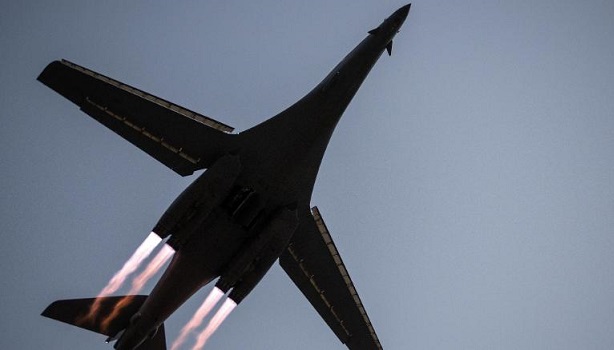 A B-1B Lancer takes off from Al Udeid Air Base, Qatar, to conduct combat operations. PHOTO COURTESY: CNN
A B-1B Lancer takes off from Al Udeid Air Base, Qatar, to conduct combat operations. PHOTO COURTESY: CNNA US defence official confirmed the US Air Force used B-1B bombers in the Syria strike. According to the Pentagon, air-launched cruise missiles were used to target Syrian facilities. Exact details of the weapons used were not provided to the media.
The four-engine B-1 is capable of deploying air-launched JASSM cruise missiles, which carry a 450-kilogram warhead and have a range of more than 370 kilometres.
Who's who in the Syria conflict?
US defence sources quoted by CNN did not say where the B-1s flew from, but US Air Force media earlier this month showed the bombers arriving at the Al Uldeid air base in Qatar, on the Arabian peninsula.
US guided-missile cruisers and destroyers
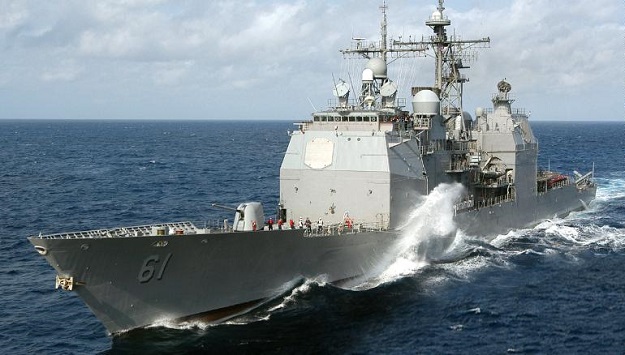 The Guided Missle Cruiser USS Monterey (CG-61) prepares to engage in a Fueling At Sea (FAS) with USS George Washington. PHOTO COURTESY: CNN
The Guided Missle Cruiser USS Monterey (CG-61) prepares to engage in a Fueling At Sea (FAS) with USS George Washington. PHOTO COURTESY: CNNUS defence sources said at least one US warship in the Red Sea participated in the Syrian strike.
The US Navy's Arleigh Burke-class destroyers and Ticonderoga-class cruisers carry dozens of Tomahawk cruise missiles with a range of up to 2,500 kilometres.
Tomahawk cruise missile
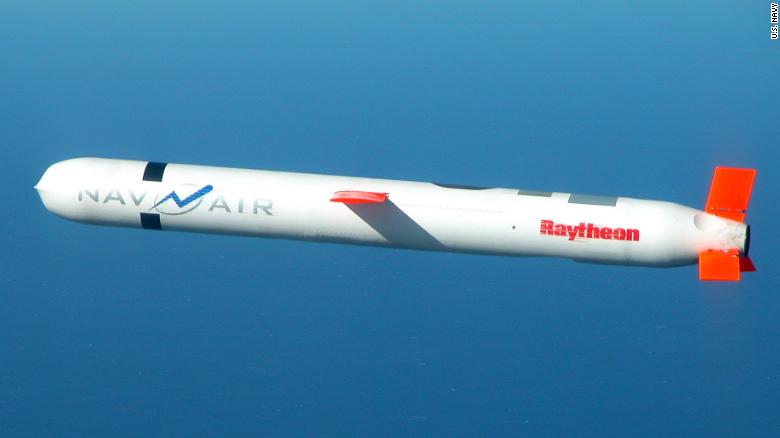 A Tactical "Tomahawk" Block IV cruise missile, conducts a controlled flight test over the Naval Air Systems Command (NAVAIR) western test range complex in southern California. PHOTO COURTESY: CNN
A Tactical "Tomahawk" Block IV cruise missile, conducts a controlled flight test over the Naval Air Systems Command (NAVAIR) western test range complex in southern California. PHOTO COURTESY: CNNThe Tomahawk cruise missile has been the US military's go-to weapon in past operations, including the one the Trump administration launched a year ago in Syria when 58 of the Tomahawks hit a Syrian airfield after an earlier use of chemical weapons.
Syria says Western attack 'doomed to fail'
The Tomahawk is carried by the dozens by US and British warships, including cruisers, destroyers and submarines, and is capable of delivering a 1,000-pound warhead.
It is designed to fly extremely low and can navigate around defences using its onboard guidance systems. Its target can also be changed mid-flight through communication with controllers.
French frigates and cruise missiles
 The French multimission frigate Aquitaine. PHOTO COURTESY: CNN
The French multimission frigate Aquitaine. PHOTO COURTESY: CNNFrance used cruises missiles fired from three of its multimission frigates and one its standard frigates during the strike on the war-torn country, sources told CNN.
Tir d’un missile de croisière naval depuis une de nos frégates multimissions cette nuit en Méditerranée. Objectif : un site de production d’armes chimiques du régime syrien. pic.twitter.com/A4hO0EtkvQ
— Florence Parly (@florence_parly) April 14, 2018
The multimission frigates are some of the newest in the French naval fleet and are armed with the MdCN (Missile de Croisière Naval) cruise missile, each ship armed with 16 missiles.
The range of the missiles is secret. The missile's manufacturer describes them as having "very long range" while various industry websites put the range at 1,000 kilometres.
This article originally appeared on CNN





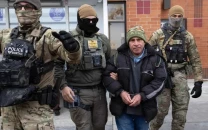













COMMENTS
Comments are moderated and generally will be posted if they are on-topic and not abusive.
For more information, please see our Comments FAQ